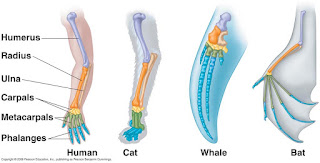Analogy/ Homology Blog Post

1. The Human, the Cat, the Whale, and the Bat are all mammals that share the homologous bone structure in the arm. As you can see with the image provided above they all share a similar bone structure including the humerus, radius, ulna, carpals, and phalanges. The homology between each species is different because of the environment they are in. For example, a bat lives up in trees or caves and uses its wings to fly from one place to another, while the whale is a sea-based mammal and uses its flipper to navigate through the water. Generally a common ancestor for these mammals was a vertebrate ancestor as they all share the trait of having vertebrae.

2. The Shark, the Penguin, and the Dolphin are all different animals that have the analogous trait of having fins. As you can see with the image provided above they all share the trait of having a fin in which helps them navigate through the water. The analogous trait is that the penguin and the dolphin have ancestors in which are not water based so they did not possess fins. So it was the change in the environment that made these animals develop the analogous trait. The bird had a reptile ancestor that did not have the fin and the dolphin was a mammal based ancestor that also did not have the fin either.
I thought that the part about the fins was really interesting. I also researched about whales and cats, but the analogous traits were harder for me to find. I think your example is very effective in explaining what analogous traits are and how they appear in different species. We must always look at the underlying bone structure to distinguish it and not simply at the outlying features.
ReplyDeleteAbner,
ReplyDeleteIts pretty incredible how us humans share the same homologous bone structure in our arms as do cats and whales. The similarities are all there. I like how you gave examples of the functions of each mammal. I wouldn't have thought that the penguin actually had the analogous trait of a fin alike with the shark and dolphin, since the penguin is a bird. It's amazing how the ancestor was not water based and how evolution has changed these species. Its great to know that their ancestors are complete different from these species.
Abner,
ReplyDeleteI thought it was so interesting to read that so many different species like the cat, the bat, the human and the whale can share a same structure but yet they are completely different species that come from different environments. i wouldve liked to see if one species had more advantages with how they were structured compared to the others when they share the same bones. I was completely clueless these animals had so much in common, it is great to be learning about it all, thank you!
The guidelines asked you to choose a homologous trait and an analogous trait and then compare two species that possessed these traits. I appreciate the comparison of four species in the homologous section and three in the analogous, but it would have been to your benefit to focus only on two at a time so you could provide more detail for each species.
ReplyDeleteThe opening section in both the homologous and analogous areas asked for a description of your species, not just identification. This would help your reader understand the environment and behavior of the species to better understand why their traits evolved the way they did. Needed to be expanded.
Okay on your discussion of the traits themselves, but again, focusing on two species would have been preferable with more detail provided.
With regard to ancestry, since all four of these species are mammals, can't we just identify the common ancestor as an archaic mammal? "Vertebrates" include any species with a vertebral column, all the way back to fish, who did NOT possess the limb structure you are comparing. We know that the archaic mammals DID possess the primitive mammalian limb structure and passed that onto these modern species, with changes occurring as a result of environmental differences. That is what we need to know to confirm homology.
Good image.
Actually, while it would have been advantageous to just compare two species (any two of these three would have worked) a very good description of your analogous traits and you do a great job of walking your reader through the ancestral path that logically explains why these traits are indeed analogous and not the product of a common genetic origin. Good.
Good image as well.